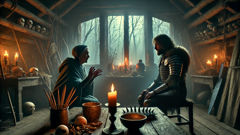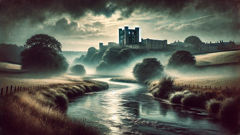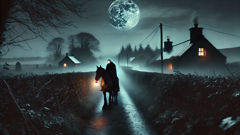Introduction
In the ancient green heart of County Durham, where the River Wear winds its silver ribbon through wild meadows and dense, whispering woods, a legend grew as tangled as the roots of its mighty oaks. On mist-laden mornings, when dew clung to brambles and the castle’s towers pierced the low clouds, villagers told stories that curled like smoke from cottage chimneys—stories of creatures old as the hills, of curses and courage, and of a serpent so vast its shadow could swallow a man. Among these tales, none gripped the people more tightly than the legend of the Lambton Worm. It was a story mothers shared by candlelight, a warning to children tempted by forbidden streams, and a secret that echoed in the stones of Lambton Castle itself. The Worm, they said, was born from a careless act, a sin of youth that festered and grew monstrous with the passing years. Its coiled body, armored with scales harder than any smith’s iron, writhed across the land, bringing blight and terror to all who dwelled beneath its gaze. Yet, at the heart of this darkness, hope glimmered—a promise that one day, the heir of Lambton would return to right his wrong, to face the beast he had unleashed. This is the tale of that fateful battle: of young John Lambton’s exile and return, of the bond between land and family, and of the ancient powers that sleep beneath England’s soil. To walk the banks of the Wear today is to hear the faint echo of this legend, humming in the rushes and the river’s song, a reminder that courage can shape even the darkest of destinies.
I. The Boy by the River and the Forbidden Catch
Long before the Lambtons bore the weight of legend, their lands were simple, dotted with flaxen fields and quiet sheepfolds. John Lambton was the youngest of his line, a boy whose restlessness marked him as different. Where others tended to chores, John slipped away at dawn, fishing rod in hand, drawn by the siren song of the Wear. He wasn’t cruel, but he was careless—heedless of warnings from his father, who reminded him that Sunday was for worship, not for sport.

On one such morning, with bells tolling in distant Chester-le-Street, John stood alone on a stony bank. The river was swollen from spring rains, its surface broken only by the flicker of trout. He cast his line, more to defy than to catch. But what he hooked was neither trout nor eel; it was something wholly unnatural. The line jerked, nearly pulling him in. When he dragged his catch onto the bank, his heart pounded—not with pride, but with dread.
The creature was black and slimy, its body thick as a man’s arm and its mouth gaping, lined with needle teeth. It writhed and hissed, coiling itself in knots. John’s first instinct was to kill it, but revulsion warred with curiosity. Was this a fish, an adder, or something else? He remembered stories of river spirits, of things that should never be disturbed. Yet, afraid to carry such a horror home, he flung it into a nearby well and tried to forget.
But the land did not forget. Over the weeks that followed, strange things began to happen. Sheep vanished from their pens, and the well’s water soured. At dusk, villagers whispered of a shadow slipping through the hedges, leaving a trail of rot where it passed. The old folk muttered that the boy had meddled with powers best left alone. John grew restless, guilt gnawing at him like a persistent toothache. The priest’s words during Sunday mass rang in his ears: every sin, no matter how small, leaves a mark.
As John reached manhood, the burdens of his house grew heavier. He was never meant to be a hero; his hands knew fishing rods, not swords. Yet every night, the river called to him in dreams, its waters swirling with dark shapes and accusing eyes. And in his waking hours, he heard a new terror in the village—a tale of a serpent grown monstrous, coiled beneath the land, waiting.
II. The Curse Grows: The Worm Awakens
The years passed, and John Lambton, restless and shamed by rumors, sought escape. He left his father’s halls to join the Crusades, hoping war would redeem him or at least drown out the whispers. In his absence, the curse he’d set loose began to fester.

The Lambton estate, once lush and fertile, withered under a growing blight. Crops failed without reason, cattle wasted away, and children fell ill. In the center of it all, the old well—where John had cast his catch—became a place of dread. Slime bubbled from its depths, and a thick miasma clung to its stone rim. No villager dared to draw water from it, and at night, eerie lights flickered beneath its surface.
Then came the first true sighting. A shepherd, braving the woods at dusk, returned pale and speechless. He spoke of a monstrous worm—longer than ten men, with a head like a dragon’s and eyes that burned with green fire. It wound its way from the well each night, scouring the fields for prey. Where it passed, grass shriveled and birds fell silent. Its appetite seemed endless. Sheep were devoured whole, and in the mornings, only tangled fleece or cracked bones remained.
Panic swept through the village. Men formed hunting parties with spears and torches, but none returned unscathed. Arrows bounced off the creature’s iron-hard scales, and its tail could snap an oak tree like kindling. The bravest knights in County Durham tried their luck—only to vanish or limp home broken.
In time, the worm grew bolder. It coiled itself about Lambton Hill, encircling the castle itself, crushing stone and snapping ancient yew trees. Each night, it slithered down to the river for water, sending ripples across the land. Its presence drew storm clouds; lightning danced along its armored back, and thunder shook the windows of Lambton Castle.
Desperation forced the Lambtons to bargain. Each day, they left a trough of milk outside their gates—a peace offering. The worm would drink, leaving the village in uneasy safety. But the cost was steep: with each passing season, the land grew poorer, and hope faded like sunlight on a stormy day.
Stories spread beyond County Durham. Pilgrims avoided the region, calling it cursed. Priests muttered about God’s wrath and penance unpaid. Only the oldest villagers remembered the day John Lambton had caught something unholy by the river. As the worm’s shadow spread, so too did the certainty: only he, the wayward heir, could set things right.
III. The Return of the Heir: Penance and Prophecy
John Lambton’s years abroad were marked by violence and guilt. He fought beneath foreign suns, his blade red with the blood of infidels and innocents alike. Yet peace never found him. On restless nights, he saw visions of a coiled beast devouring his homeland. Word reached him even in distant Antioch: his family’s lands were dying, and a horror lurked where he’d once played as a boy.

Haunted by regret, John returned at last. The hills of Durham looked older, bowed beneath gray skies. The castle stood battered but unbroken; its stones bore fresh scars. Villagers eyed him with suspicion and fear. He found his father thin and careworn, his hair turned white. The old lord spoke little but pointed to the well—now a pit of corruption—and to the battered milk troughs by the ruined gates.
John sought guidance from the wise woman of the woods, an ancient crone known for her knowledge of old ways. In her smoky hut, among herbs and bones, she listened as he confessed all: his Sabbath fishing, the unholy catch, the careless abandonment. Her eyes gleamed with secrets as old as the Wear itself.
“You’ve woken a thing that sleeps beneath the world,” she whispered. “A curse born of pride, fed by fear. To slay it, you must be both brave and cunning.”
She told him of the worm’s strengths: its armored hide, its venomous breath, its power to regrow any part severed unless each piece was burned. Most chilling was her warning: a prophecy that to kill the beast would exact a price.
“Before you go to battle, you must place a promise upon yourself. Should you fail to keep it, sorrow will find you and your kin. When you face the worm, wear armor bristling with spear points—let no part of you touch its flesh. And when you triumph, kill the first thing you see on your return home, or else your line shall bear the curse forever.”
John’s resolve hardened. He forged armor lined with blades, sharp as a forest of knives. He planned with his father: when he returned victorious, his father would release a hound to greet him first. In this way, John could slay the beast and break the curse without blooding his own kin.
The morning of reckoning dawned cold and silent. John armed himself and descended to the riverbank, where fog coiled like a memory. As he waited for the worm to rise from its lair, he offered a silent prayer—for forgiveness, for courage, and for an end to the darkness he had sown.
Conclusion
The battle between John Lambton and the Worm became the stuff of legend—a clash that rattled the very stones of County Durham. As the monster rose from the river’s depths, its eyes blazing with ancient malice, John stood unflinching. The Worm struck first, coiling about him with crushing force, but the spikes of his armor pierced its flesh at every turn. Black ichor poured from its wounds, hissing as it touched the earth. With every twist and lash, the beast grew weaker, until finally John drove his blade through its head and severed the writhing body piece by piece, casting each into a roaring bonfire at the river’s edge. The land itself seemed to sigh in relief as the darkness lifted from Lambton Hill.
Yet victory brought no simple joy. Remembering the wise woman’s words, John rushed back toward his father’s gates, only to see his father—overcome by relief and pride—run to greet him before the hound could be loosed. John’s heart broke as he realized he could not fulfill the prophecy’s final demand without committing an unthinkable act. He embraced his father, tears mingling with soot and blood, accepting that some curses are woven too tightly to be undone. The Lambton line would bear its burden for generations to come.
But in time, the land healed. The river ran clear once more, crops flourished, and the people of Durham found courage in their own hearts. John Lambton’s story became a legend not only of monsters and curses, but of human failing and redemption—proof that even the darkest deeds can be met with bravery and hope. Today, the winding Wear still carries whispers of the Worm, a reminder that our choices shape both our fate and that of the world around us.













